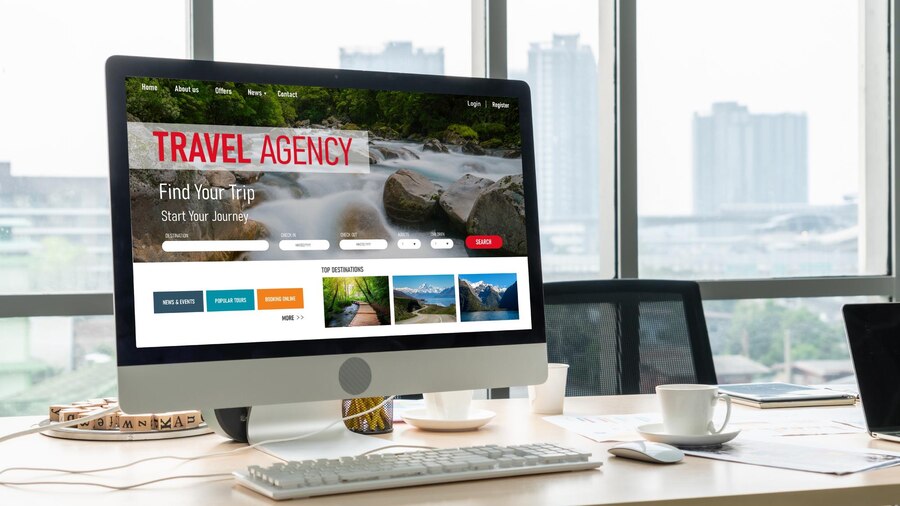Building websites for Agra’s tour operators and travel agencies is a rewarding venture that can significantly enhance their online presence and attract more customers. Here’s a step-by-step guide to help you create effective and appealing websites tailored to the needs of Agra’s tourism sector:

Table of Contents
Toggle1. Understand the Market
Before starting the website development process, it’s essential to research the local tourism industry:
- Identify Target Audience: Understand the demographics of tourists visiting Agra, including their preferences and interests (e.g., cultural tours, historical sites, local experiences).
- Research Competitors: Analyze existing websites of tour operators and travel agencies in Agra. Identify their strengths and weaknesses to find opportunities for improvement.
2. Define Website Goals
Establish clear objectives for the websites you will create:
- Showcase Tour Packages: Highlight various tour packages, including pricing, itineraries, and unique selling points.
- Promote Local Attractions: Include information about key attractions in Agra, such as the Taj Mahal, Agra Fort, and local markets.
- Facilitate Bookings: Implement an easy-to-use booking system for customers to reserve tours or make inquiries directly through the website.
3. Choose the Right Platform
Select a website development platform that suits the needs of tour operators and travel agencies:
- Content Management Systems (CMS): Consider platforms like WordPress, Joomla, or Drupal for their flexibility and ease of use.
- E-commerce Solutions: For agencies focusing on online bookings, platforms like Shopify or WooCommerce can be effective.
- Custom Development: If you need advanced features, consider custom web development using technologies like HTML, CSS, JavaScript, and backend frameworks (e.g., PHP, Python).
4. Design User-Friendly Layouts
Create a visually appealing and user-friendly website design:
- Responsive Design: Ensure the website is mobile-friendly, as many users will access it from smartphones and tablets.
- Intuitive Navigation: Organize the website structure with clear menus and categories to help users find information easily.
- High-Quality Visuals: Use high-resolution images and videos of Agra’s attractions and tour experiences to engage visitors.
5. Incorporate Essential Features
Include key features that enhance functionality and user experience:
- Booking System: Implement an online booking system with secure payment options. Consider integrating APIs from popular booking engines if needed.
- Contact Forms: Include contact forms for inquiries, allowing potential customers to reach out easily.
- Testimonials and Reviews: Display customer testimonials and reviews to build trust and credibility.
- Blog Section: Consider adding a blog to share travel tips, local insights, and updates about Agra, which can also improve SEO.
6. Optimize for Search Engines
Implement SEO best practices to improve the website’s visibility on search engines:
- Keyword Research: Identify relevant keywords related to Agra tourism, such as “Agra tour packages,” “Taj Mahal tours,” and “Agra travel guide.”
- On-Page SEO: Optimize page titles, meta descriptions, headings, and content with relevant keywords.
- Local SEO: Register the business on Google My Business and optimize the website for local searches to attract nearby tourists.
7. Implement Social Media Integration
Integrate social media channels to increase engagement and reach:
- Social Media Links: Include links to the agency’s social media profiles for easy access.
- Sharing Options: Add social sharing buttons to blog posts and tour packages, encouraging visitors to share content with their networks.
8. Ensure Compliance and Security
Make sure the website complies with legal requirements and is secure for users:
- GDPR Compliance: If targeting international tourists, ensure compliance with data protection regulations like GDPR.
- SSL Certificate: Install an SSL certificate to secure data transmitted through the website, especially during transactions.
9. Test and Launch the Website
Before launching, conduct thorough testing:
- Functionality Testing: Ensure all features, forms, and booking systems work correctly.
- Cross-Browser Testing: Test the website on different browsers and devices to ensure compatibility.
- User Testing: Gather feedback from a small group of users to identify areas for improvement.
10. Provide Ongoing Support and Maintenance
After the launch, offer ongoing support and maintenance services:
- Regular Updates: Keep the website updated with fresh content, tour packages, and images.
- Technical Support: Provide technical assistance to resolve any issues that may arise.
- Analytics Monitoring: Use tools like Google Analytics to track website performance and user behavior, allowing for data-driven improvements.
Conclusion
Building websites for Agra’s tour operators and travel agencies involves a blend of creativity, technical skills, and an understanding of the local tourism landscape. By focusing on user experience, integrating essential features, and optimizing for search engines, you can create impactful websites that enhance the visibility and growth of Agra’s tourism industry. As you embark on this journey, remember that your work can help showcase the beauty of Agra and promote its rich cultural heritage to a global audience.


No responses yet